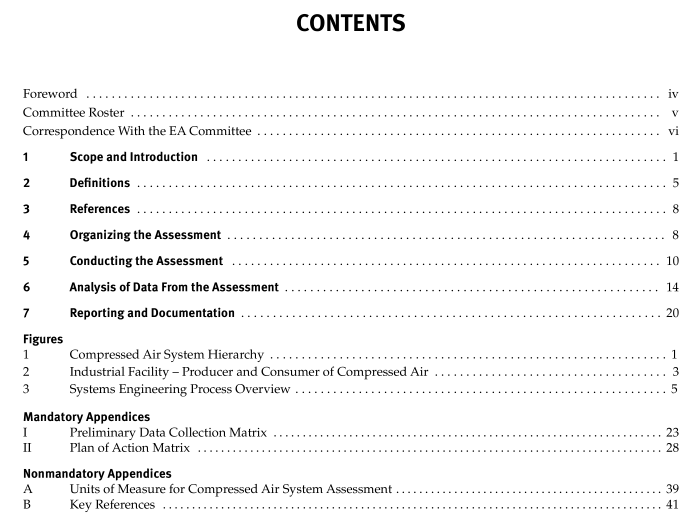ASME EA-4 pdf download

ASME EA-4 pdf download Energy Assessment for Compressed Air Systems
Assessments involve collecting and analyzing system design, operation, energy use, and performance data and identifying energy performance improvement op- portunities for system optimization. An assessment may also include additional information, such as recommen- dations for improving resource utilization, reducing per unit production cost, reducing lifecycle costs, and im- proving environmental performance related to the as- sessed system(s).
Assessment activities include, but are not limited to, engaging facility personnel and provid- ing information about the assessment process; collecting and analyzing data on system design, operation, energy use, and performance; identifying energy performance improvement opportunities; and making recommenda- tions for system improvement and implementation in a written report. This report should document system design; quantify energy operation and performance data; document the assessment process; show results, recommendations, and energy savings projections; and improve facility personnel’s understanding of system energy use and operation. This Standard sets requirements for
(a) organizing and conducting a compressed air sys- tem assessment
(b) analyzing the data from the assessment
(c) reporting and documentation of assessment f ndings When contracting for assessment services, plant personnel may use the Standard to def ne and communicate their desired scope of assessment activity to third party contractors or consultants
1.2 Limitations This Standard does not provide guidance on how to perform an assessment for compressed air systems but sets the requirements that need to be met during the assessment. For additional assistance, see the companion ASME Guidance for ASME EA-4 Energy Assessment for Compressed Air Systems on how to apply this Standard.
(a) This Standard does not specify how to design a compressed air system. (b) This Standard does not specify the qualif cations and expertise required of the person using the Standard.
(c) This Standard does not specify how to implement the recommendations developed during the assessment but does include recommendations for implementation activities.
(d) This Standard does not specify how to measure and validate the energy savings that result from imple- menting assessment recommendations.
(e) This Standard does not specify how to calibrate test equipment used during the assessment.
(f) This Standard does not specify how to estimate the implementation cost or conduct f nancial analysis for recommendations developed during the assessment.
(g) This Standard does not specify specif c steps re- quired for safe operation of equipment during the assess- ment. The plant personnel in charge of normal operation of the equipment are responsible for ensuring that it is operated safely during the data collection phase of the assessment.
(h) For outside individuals working in a private or publicly owned company facility, issues of intellectual property, conf dentiality, and safety shall be addressed before beginning an assessment. While the importance of satisfying these requirements and related issues is ac- knowledged, they are not addressed in this Standard
1.3 Introduction — Using the System Assessment Standard Industrial facilities use compressed air as an essential energy source to power tools or machines and for pro- cess applications. Characteristics of compressed air, such as responsiveness and safety, make it an effective and de- sirable means of delivering energy to production. There are many end uses of compressed air energy applied to all types of different industries. No two com- pressed air systems or compressed air system assess- ments are identical.
Therefore, this Standard is provided as a f exible framework that, when applied to the wide variety of industrial compressed air systems, can accom- plish an effective energy and performance assessment. The system assessment framework is presented as a ma- trix of assessment objectives, action items, and methodolo- gies. The matrix approach is intended to facilitate selection of activities to be performed in the assessment. Two matri- ces, “Preliminary Data Collection” and “Plan of Action,” are presented in Mandatory Appendices I and II. E
ach matrix includes required elements and supplemental ele- ments of assessment activity. Required elements primarily focus on energy reduction benef ts and apply to virtually all compressed air systems. Supplemental elements de- scribed in each matrix do not apply to every system or have primarily nonenergy related performance benef ts. Ultimately, use of this Standard is at the discretion of those participating in the assessment. The assessment team (see para. 4.1), working with production process in- formation and compressed air system knowledge, shall establish the plan of action and statement of work (SOW) for the assessment. Plants that desire full conformance with this Standard shall complete all required elements of activity. Required elements, assessment objective, action item, and method- ology are shown in Mandatory Appendices I and II using black text with white background. Each required ele- ment, assessment objective, and action item shall be in- vestigated using one or more methodologies also shown in black and white text.









